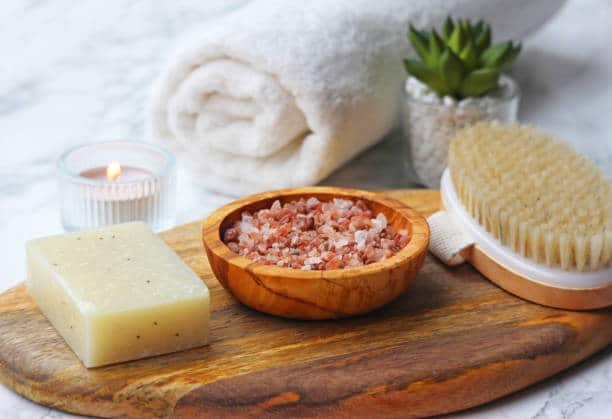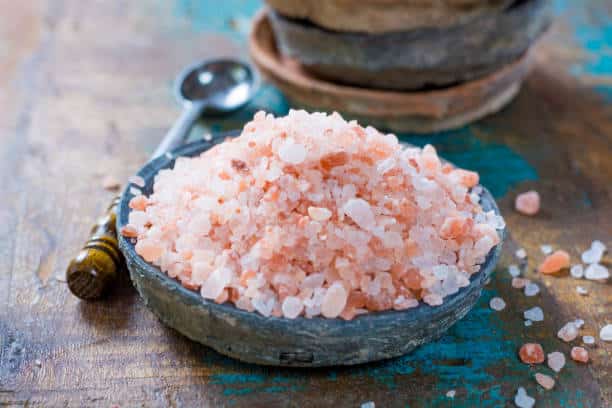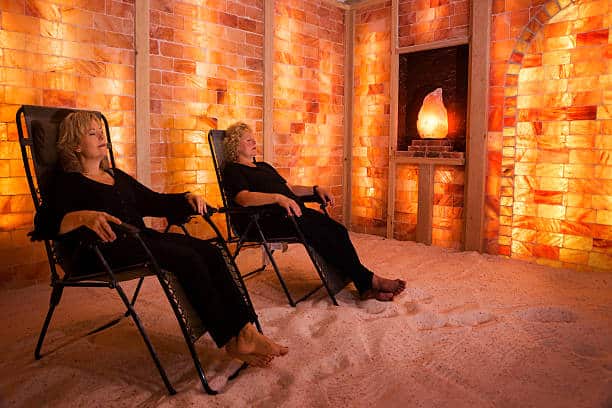The best salt in the world is Himalayan pink salt because it has numerous health advantages and is more nutrient-rich for human consumption than other salts. Himalayan pink salt has been used to season food since it was discovered millions of years ago. It has a long history of being valued as a spice and is naturally found in the Himalayan Mountains. This salt is also a well-liked component of cosmetics and other beauty items because of its pink color and its benefits for the skin.
The Himalayan pink salt was produced by evaporation, and underground geologic processes date back millions of years. Numerous minerals are present in this salt, which is derived from the Himalayan region in Asia. The Himalayas contain large blocks of red minerals in caves where pink-colored water has formed due to a combination of different minerals in the water and an incredibly high salt content. These minerals are presumed to have a significant impact on our body’s capacity to adapt to a variety of conditions.
The interior sea beds of these mountains, where this salt is mined, were once covered by lava. Copper and zinc are the two elements that give Himalayan pink salt its bright pink hue. These two major minerals, copper and zinc, are essential to human health and are frequently regarded as aiding substances that the body requires for both good health and survival.

WHY PEOPLE LOVE TO USE HIMALAYAN PINK SALT
Mining, Collection, and Preservation of Himalayan Pink Salt
The lava formed a natural barrier, preventing pollutants and other contaminants from reaching the salt. Due to this built-in defense, many people believe that Himalayan pink salt is the purest salt on the planet. At first, it was a preservative or ingredient utilized by the Himalayan people. This allowed their meat and fish to remain fresher for a longer period of time. Also, the reason why pink salt is so popular for trading in Nepal’s valleys and neighboring regions.
The massive mines, which reach nearly half a mile into the mountains, have many levels and are limited to 25 tunnels. Himalayan pink salt is produced in Pakistan’s salt mines, close to the Himalayan foothills, and it is taken out of the mines by hand labor. The only and biggest source of pink salt in the world, the Khewra mine produces more than 300,000 tons of Himalayan pink salt annually.
The Himalayan people traversed rugged, cliffside, and mountainous terrain to trade this priceless good, using yaks to carry the salt. To preserve the purity of the product, the mining of this salt is strictly regulated in this area. Additionally, It is anticipated that the mine has 600 million tons of salt deposits. According to estimates, there is enough salt in this world’s stockpiles to last for hundreds of years.
This salt has different nicknames in the Himalayas, like “saindhava lavana,” “halite,” or rock salt. As previously mentioned, thousands of workers mine the mountain, using picks and shovels or just their bare hands, before loading it into wheelbarrows and wheelbarrow carts. Sadly, the young miners’ strategy for obtaining pure salt for free after leaving the mine was not entirely moral. In an effort to get rich, a few of the miners tried to steal the mountain salt from their employers and resell it to them at a much lower price.
Usefulness for Food And Cooking

The use of table salt is comparable to that of Himalayan pink salt, but the latter has more minerals than regular table salt. It is regarded as a true gourmet cooking salt by well-known chefs. It additionally adds a special touch that can improve your cuisine by giving food a distinct texture and an intriguing pink color. This salt is a great addition to food when grilling, roasting, or seasoning. But not just home cooks or those who work in upscale restaurants find the presence of Himalayan pink salt to be enticing.
Its pink color draws attention to the aroma and lends the food a touch of sophistication. It is best to avoid using it excessively, although Himalayan pink salt is not used to flavor items that are frequently salted because it is naturally salty. Instead, it is only used to prepare high-end specialties when high-quality salt is required, like marinated meats or caviar. Himalayan salt is frequently referred to as the “black diamond” of salts, and in this context, it can be compared to gems like rubies and diamonds; before realizing it is salt, one could mistake it for any precious stone.
However, it is unrivaled and exquisite in taste and color, just like the most expensive gems. In contrast to regular sea salt, which can cost little, rock salt is so highly regarded that the price of a pound of it goes up and up every time, depending on scarcity and availability. In addition to being preferred by chefs and food experts, the region’s salt has attracted a lot of interest from the general population because of its inexpensive cost and extraordinarily good quality.
Even though it has a nice appearance, this product is expensive. Himalayan pink salt can be up to 20 times more expensive than regular table salt, costing $5 to $8 for 100 grams compared to another common brand’s salt, which costs about $1. It is reasonable to assume that both sea salt and Himalayan salt would be adequate sources of nutrients for the human body, notwithstanding the disparities in their relative costs as compared to other food sources.
Therapeutic Advantages of Himalayan Pink Salt

Enhances Digestion while Controlling Body Water
Himalayan pink salt helps the body regulate its water balance by reducing bloating, softening and neutralizing meals, curing diarrhea, and lowering high blood pressure. It is advised to use it in salad dressing, food like soups and stews, and drinking water. Himalayan salt can also cure constipation, decrease blood pressure, and repair gastric ulcers. Because it supports proper function and maintains a stable pulse rate, doctors frequently advise using Himalayan salt to treat high blood pressure.
Boosting of Libido
The libido is increased by Himalayan pink salt, which might lead to more fulfilling sex. Himalayan pink salt contains a variety of minerals as well as significant antioxidants such as vitamin E, beta-carotene, lycopene, and vitamin E. Additionally, researchers have found that regularly consuming Himalayan pink salt lowers blood sugar levels and may possibly help prevent disease.
Recently, researchers discovered that Himalayan salt might increase libido in both men and women. The impacts on the body and mind must be understood in order to comprehend what Himalayan pink salt does for the libido. The process involves dissolving salt in hot water, which creates ions that enter the body and fill spaces in the blood plasma membrane.
Enhancing Peaceful, Deeper Sleep
Due to the salt’s propensity to promote sleep, retailers sell it under the name “Himalayan pink salt.” It is believed that it aids in the regeneration of muscles and tissues during exercise by accelerating the transfer of water through the body. Himalayan salt can help you sleep better, but your doctor may advise eating foods high in magnesium to help you recover from exercise faster.
This salt, according to many yogis and massage therapists, has a variety of therapeutic properties, including purification, detoxification, the removal of bacteria and toxins, the improvement of bodily fluids, the generation of red and white blood cells, and the control of bodily secretions.
Minimizing Sinus Infections
Reducing sinus infection problems Himalayan pink salt is said to cure sinus issues, headaches, and depression, and customers typically report feeling fantastic after using it. Customers feel fantastic after consuming the Himalayan pink salt with hot water, noting that it cures sinus issues, migraines, and sadness.
It treats sinus infections, colds, congestion, and constipation without the unpleasant side effects or awkward circumstances related to medications or injections. Himalayan pink salt also prevents sinus infections by getting rid of the toxins that irritate your nasal membranes and make them sick.
Strengthens the Bone

Increased bone growth is a benefit of pink Himalayan salt. It is a great supply of calcium, potassium, and magnesium, all of which support bone formation and strength. In addition to being beneficial for allergies, aches and pains, arthritis, and other mild ailments, this salt is helpful for the blood since it includes nitrate.
In the event that it is used to treat “gout,” it aids by reducing harmful uric acid levels in the body and preventing them from rising. Osteoporosis is a condition in which the bones become brittle and fragile due to tissue loss. It is often brought on by hormonal changes, a lack of calcium or vitamin D, or both. A calcium-rich food supplement, such as Himalayan salt, is useful in avoiding this condition.
It Smooths Out Wrinkles
Himalayan pink salt promotes healthy hair and smooths out facial wrinkles. It also works well on all kinds of burns and skin diseases. Consumers initially enjoyed its taste in food, so it is now being used in shampoos, detergents, and pet food. Additionally, it has been used to treat sore throats and is a natural remedy for eczema and psoriasis. It may even have some anti-cancer effects. Himalayan pink salt benefits the skin because magnesium is necessary for healthy muscle function and aids in the body’s utilization of iron. It can also be applied topically to heal wounds.
Minimizing Cramp
Another benefit of Himalayan salt is that it reduces cramping. These cramps are more painful than the typical discomfort that a person experiences when they are ill or are experiencing a condition. The twinges of muscle and joint discomfort that accompany these cramps are typical. Osmotic pressure, a distinctive characteristic of salt, is supposed to be helpful in treating muscle cramps.
However, Himalayan pink salt has 2–6 times as much magnesium as regular table salt. You’ll learn what causes muscle cramps in the first place, why the osmotic pressure of it is so exceptional and why it works to relieve cramps, and how Salt Therapy can help you obtain a better night’s sleep.
Other Uses of Himalayan Pink Salt

Rock salt crystals that have been hollowed down to accommodate a lightbulb are used to create Himalayan salt lamps. They emit a warm, reddish-pink glow when you light them. These decorative items, according to their sellers, offer more than just light. Among other advantages, they assert that the lights can elevate mood, enhance sleep, reduce allergy symptoms, facilitate easier breathing, and purify the air. Additionally, the majority of spas and therapeutic facilities all over the world use Himalayan salt lamps for lighting and illumination.
Furthermore, when using Himalayan salt to manufacture salt slabs, serving plates, baking stones, skillets, and tequila shot glasses, tiny amounts of salt transfer to the meal or drink and change how its flavor is represented. The flavor of food and other products is thought to benefit particularly from Himalayan salt. Except that we continue to rely on the underlying presumptions of the majority of people and the advocates, the scientific evidence of its health benefits is essentially insufficient to make it broadly acceptable.
Sales of pink Himalayan salt are now more expensive than those of other salt types as a result of marketing initiatives. Due to its high price and propensity for browning when exposed to air, Himalayan salt is normally properly maintained. The false belief that it is healthier than most conventional table salt has been prompted by the fact that it is not processed and is constantly in its natural state without utilizing any chemicals for its caking.
Contradiction and Unproven Belief

Himalayan salt contains 96% to 99% sodium chloride and a small number of additional components. Regarded to contain pollutants that render them inappropriate for use in food or industry, some salts mined in Pakistan are thought to be one of these. Some salt crystals from this site are off-white to translucent in appearance, even though some salt veins’ trace minerals give them a pink, crimson, or light-red color.
To be of any clinical importance, the changes in mineral concentration would need to be extremely substantial. The problem of iodine deficiency has significantly diminished in many countries where iodine is added to commercial table salt. Himalayan salt is deficient in the health benefits of iodine supplementation. However, by proving that Himalayan salt cannot offer significant health benefits, the company that sells it must reduce the price of its product, inferring that it must do so.
Since common salt is a solid mineral compound with the formula NaCl and is made completely of sodium and chloride ions, it would have to provide some sort of alternate explanation for the health advantages. Since most people are unlikely to believe that Himalayan pink salt is any less healthy than regular salt, they would need to offer another justification for its health advantages. The inorganic chemical compounds common salt and Himalayan salt share the same chemical formula, although they act very differently.
In addition to having several crucial physiological roles in the body, such as controlling muscle contraction, enzymatic reactions, nerve impulses, and many other processes, calcium is known to encourage bone growth and tooth creation in humans. There are neither actual nor fictitious advantages to Himalayan pink salt.
Other Different Varieties of Salt
There are many types of salt available in the world, and they come in a variety of sizes, colors, and nutrient compositions, including pink, black, table, and others. However, we’ll highlight a few of them for clarification. Here is a list of the majority of the best ones, along with their importance as spices.
Table Salt
The flavor won’t linger because the taste is delicate and won’t ever overpower your food because iodine is added to most table salts. Table salt undergoes extensive processing, is mineral-free, and frequently includes an anti-caking additive. The majority of people won’t even notice the taste of table salt until they switch to one of the healthier substitutes, like Himalayan rock salt or sea salt.
This is because the flavor of table salt is so mild. The difference between good-tasting sea salt, rock salt, and table salt is still very noticeable once a person tries the other options and learns that they are even better tasting than table salt, even though most people’s taste buds are not capable of detecting the difference.
Black Salt
Black salt (Kala Namak), which is frequently used in Southeast Asian cooking, has a potent sulfuric smell from the Indian spices and herbs that are heated into it at incredibly high temperatures, making it black salt. Almost every ingredient list and the recipe for noodle dishes contain black salt, despite the fact that it is rarely used in Japanese cooking.
Black salt can be used in the kitchen for a variety of tasks despite having a strong flavor. Vegetables and meat stay tender and juicy when seasoned with black salt. When used in cooking, black salt is said to preserve food, keep moisture in it, give it a black appearance, and give it a unique flavor and texture. However, due to black salt’s peculiar characteristics, it is a little difficult to understand how these applications work.
Sea Salt
Because of its flavor and the nutrients it carries, sea salt is another type of pure salt that is frequently consumed. Sea salt is not at all comparable to table salt, which is named “table salt” despite having a lower sodium chloride content (70 percent vs. 45 percent). This salt is extracted all over the world from evaporating seawater. Depending on the minerals it contains, it can have a fine, coarse, or flaky texture and a variety of colors.
The most luxurious salt, fleur de sel, which translates to “flower of salt,” is manually gathered from French coastal salt ponds. Over time, many of France’s salt ponds have been swept away, but fleur de sel is also made from deposits that are often hidden below. Most sea salt is harder than table salt, and some kinds have nearly as much sodium chloride as pure seawater. High-quality fleur de sel is softer than table salt and has a butterier, more neutral flavor.
Conclusion
Finally, salt is a significant, widespread, and generally safe substance that is still used daily in both developed and developing countries all over the world. It has been important throughout human history. Salt has a big impact on many facets of human civilization because it is an essential component in food preparation, the composition of medicine, and other beauty products. Even in extreme situations like starvation or when they have very little money, the majority of societies in the past, present, and future will rely heavily on salt as a dietary staple.
In addition to being an essential nutrient, salt preserves fresh food and was a valuable resource in the early modern and medieval periods. Salt has been popular since the beginning of time, so Hilamayan Pink Salt was able to take advantage of this popularity to become well-known today. Given how frequently people use salt, Himalayan pink salt has received more attention lately. Although salt has been a staple in many societies for a long time, Himalayan pink salt has recently become popular as people have begun to recognize its tremendous value as a seasoning.
https://www.bluehost.com/track/allprenuer
http://s.click.aliexpress.com/e/8jCEJrS?dp=221491272